
Urban intruders
City colonisers in the expanding urban ecosystem
Humans are an invasive species.
From the moment we clambered down from the trees in the African savannah, we have set forth on an unceasing conquest of the globe.
We have traversed mountains, oceans and rivers, spreading ever further. In our path, we swept away species by hunting them to extinction, or by dramatically altering ecosystems.
Alterations such as the construction of cities. By 5500 years ago, the first true cities were present. The city of Uruk, which may have harboured 40,000 people, sprung from farming communities in Mesopotamia (1).
This was the advent of the urban ecosystem, large gatherings of humans, their dwellings, and the food they require.
It brought new opportunities for pests such as mice and rats, which took to the urban ecosystem like a fish to water. Over time, great cities such as Rome and Athens were erected.
The Industrial Revolution coupled with intensified agriculture have caused cities to expand rapidly in the last two hundred years. The urban ecosystem encroaches ever further on its surroundings.
This forces the hand of fauna and flora: either adapt, or perish. New species have come into the expanding cities, using the abundant food and shelter in parks and gardens to their advantage.
Additionally, we bring animals into the city from exotic locales. To keep as pets, for their fur, or to eat. When these escape or are released, they might prosper in the urban ecosystem.
This, then, is a tale of urban intruders, of species that have recently made their home in the city. Not negative invasive species, but intruders, new arrivals.
They affect us, as our expansion has affected them. Join us as we look at what makes parakeets, boars and foxes tick in the city. But first: what are invasive species?
Invasive species
An invasive species is a non-native species that poses a threat to the ecology, economy or human health of the area where it is introduced.
Let us start with an example. The Nile perch was introduced into Lake Victoria in Africa around 1950, despite calls by ecologists not to do so (Figure 1).
It was thought that it would improve the fisheries there, and provide a boost to sports fishing. Since its introduction, more than 200 native fish species in the lake have perished.
This loss of diversity is one of the hallmarks of invasive species. Even so, the concept remains difficult to define.
It is thought, for example, that the Romans brought the rabbit to Britain almost two thousand years ago(2). Should it still be marked as invasive?
It is non-native and has proliferated, undoubtedly to the detriment of other species. And what of the impact of species already present?
If the Nile perch were introduced to a lake with large predatory fish already in place, it would not proliferate as much. Invasiveness is thus not an absolute term.
A species that is invasive in Mexico might not be invasive at all in Thailand(3).
In short, the impact of an invasive species is very much dependent on the conditions at the site of introduction(4).
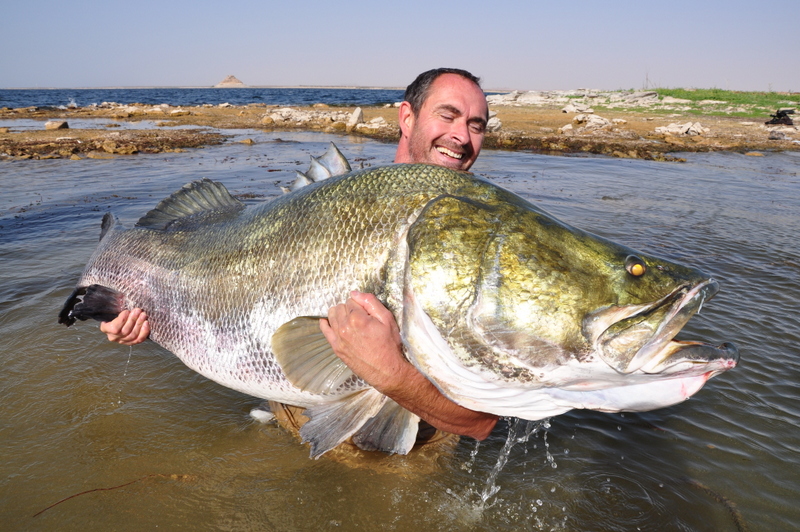
Figure 1:
A freshly caught Nile perch.
Source.
Classical invasive species are spread by humans at an accelerating pace.
We scoff at geographic barriers, the mountain ranges, oceans and deserts that prevent endless species migration.
We now traverse them easily. Knowingly or unknowingly, we carry seeds, insects or exotic animals with us.
These species can then try their luck in new locales(3). The cane toad is a good example of a species that was knowingly placed in new locales.
It was thought to be a good predator of pests in sugarcane plantations. Its introduction was successful, and then some: the toad is highly toxic and will eat most anything it can fit in its gaping mouth (Figure 2).
Additionally, it develops rapidly in tropical areas and has a wide range of suitable habitats. Due to its toxicity, native species that try to eat it die. Thus, it can spread rapidly, and decimates local wildlife(5; 6).
Since urban areas are hubs of transportation, trading of goods, and human mingling, they are easily accessible to potential invaders(7).
What do invasive species do to that makes them so dangerous?
To give a quick indication: they are thought to be responsible for 40% of historical extinctions, and the main reason that 80% of endangered species are endangered.
They are a huge threat to ecosystems(8). Why is this so?
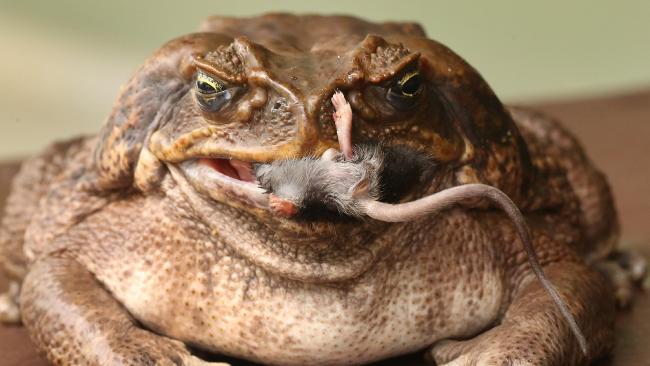
Figure 2:
A cane toad eating its catch.
Source.
Invasive species are often fast growers.
Take, for example, the Kudzu vine. It was gifted to the United States in 1876 by Japan for the hundred-year anniversary of the signing of the declaration of independence.
Its beauty was immediately appreciated. Later, the government incentivised its planting, in an effort to curb soil erosion. It was also advocated as great animal fodder.
Together, this led to enormous planting of the vine, and it grew well.
Far too well. It is now known as 'the vine that ate the South'. Large swathes of the Southern US are covered in it.
Its high photosynthetic rate, large leaf area and quick elongation cause it to overgrow railroads, power lines, and native vegetation. Trees topple under the sheer weight of the Kudzu vine.
It is now on the Obnoxious Weed List, but one has to admit that it gives a stunning view (Figure 3) (9).
Kudzu, then, has properties that make it outcompete native plants.
The Nile perch wreaked havoc because it is a voracious predator. Native species have not coexisted with such predation pressures, and cannot handle them.
In the case of invasive pathogens, the situation is similar: native species have no resistance to them, and quickly perish.
In general, invasive species escape the predation or disease pressures that limit their spread in their native area, which allows them unprecedented proliferation.
This is called the predator-escape hypothesis. The runaway population increase causes wholesale upheaval of the balance in an ecosystem, which results in negative effects on species richness and ecosystem services(3; 8).

Figure 3:
Kudzu overgrowing buildings, railways and native flora.
Source.
City colonisers
So what of our urban intruders?
They are different from classical invasive species in that they do not, per se, exert negative effects on the urban ecosystem.
Their presence does affect it, however. We wish to look at these organisms, and discover how they survive in and affect the urban environment.
In this article, we distinguish two ways in which species can colonise our cities. The first is through specific human efforts.
We travel, we take animals and plants, and we have pets. When people unthinkingly empty an aquarium with leftover plants into a canal or free their parakeets, species can be introduced.
Additionally, since the urban system is similar everywhere, some core species do well in most cities and are spread around the world in this way. Think of pigeons(10).
The second way in which a species may enter our cities is locally, of its own accord. While the world's population keeps on increasing, urban areas will spread more and more into the natural environment.
This puts organisms in a tough situation. They either deal with this urban encroachment or perish. As it turns out, many prosper, populating the city with its abundant food and shelter.
Plants that are used to living in dry and harsh conditions try their luck in the urban heat island. Birds that nest in rocky outcrops find a whole space filled with stone structures.
Foxes find that human food refuse is an excellent source of nutrition, and that parks are ideal hiding spaces. These intruders have successfully adapted without specifically being brought to the cities.
Rose-ringed / Ring-necked parakeet
The rose-ringed parakeet (Psittacula krameri) is a bird that has successfully established non-native populations in urban areas in 35 countries on five continents.
For centuries, it has been a beloved cage bird, and it was widely imported to Europe until import was banned in 2007(11). It is native to South Asia and Africa(4; 12).
The majority of the urban populations are of an Indian subspecies. In India, the parakeet is known as a friendly bird that lives in colonies. It is not migratory.
Their custom to live in large groups and feed on orchard fruit, maize and oil-seed crops makes them a serious agricultural pest(8; 12; 13). In Europe, these birds were kept as pets.
That is how this species originally entered our urban living space: as escaped or released household pets(13).
The non-native populations are not known as agricultural pests, instead feeding on buds, blossom, and (unripe) vegetables and seeds in the urban area(14).
They also capitalise on the bird feed available in cities(13). Their introduction to the urban area might impact native species in several ways, both negative and positive.
Both effects have been recorded, but research is still ongoing, and much remains to be determined(11).
We'll discuss the following topics: competition for nesting places, aggressive behaviour towards predators and foraging behaviour.
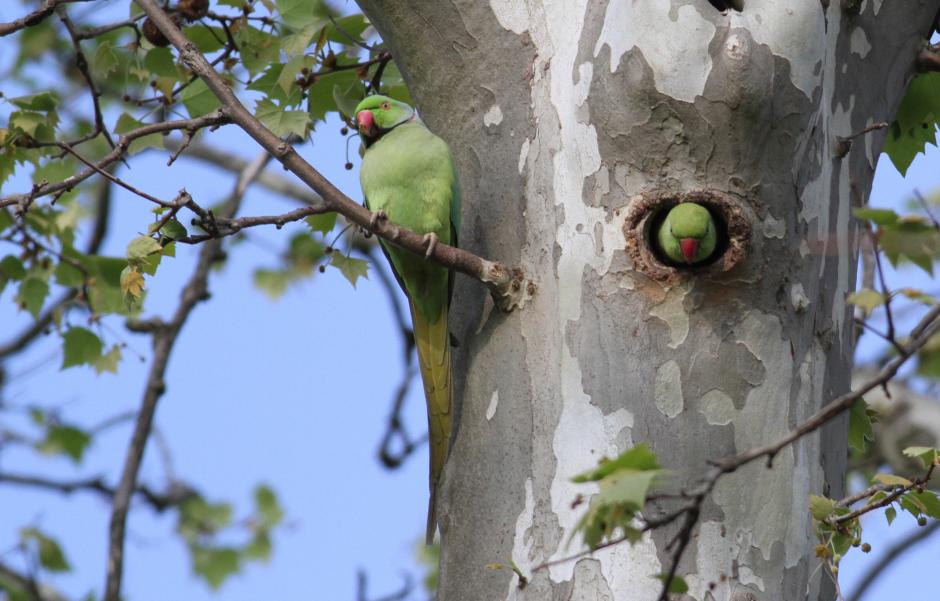
Figure 4:
A rose-ringed parakeet couple in its nest in Toulouse, France.
Source.
Nesting
Rose-ringed parakeets are secondary cavity nesters.
This means they do not build a nest of their own, but rather use natural or abandoned cavities (Figure 4).
In their native habitat, they compete for nests with other cavity nesters(8).
In their new habitats, they might outcompete native cavity nesters.
Rose-ringed parakeets need medium-sized cavities, but these are in short supply in the urban environment.
In the light of public safety, for example, decaying tree limbs are periodically removed(4).
Additionally, Rose-ringed parakeets begin nesting in late February, which is earlier than most other species(15).
This leaves two possibilities: parakeets might outcompete native cavity-nesting species because of a lack of cavities, or, if the native community of that area is poor in cavity dwellers, they could enrich the species richness.
Though there is some competition between rose-ringed parakeets and other cavity-nesting species, there does not seem to be a significant impact on those populations, at least in the UK(16).
In India, the parakeets nest in rock crevices and buildings, but in the urban jungle they mostly use cavities in trees.
This brings down the list of species the birds could compete with for nesting sites.
Rose-ringed parakeets and green woodpeckers, for example, choose the same tree species to nest in. Woodpeckers, however, make a new nest each breeding season(14).
Since the parakeets only defend their own nest, this allows other species to nest in the same tree without problems(15). In Seville, conversely, the parakeet recently started nesting in building cavities.
Here, it competes with the lesser kestrel (figure 5). The parakeets fought more than expected with the lesser kestrels , and won more than half the fights, even though their colony was small.
With increasing parakeet numbers, the lesser kestrel might be outcompeted.
The parakeet competed with a protected species of bat as well.
The bat, called the greater noctule, has declined in population size.
Abandonment of a nesting tree by the bats was correlated with parakeet presence.
As it so often is, the image is not clear-cut.
Large negative effects are not yet apparent and more research is needed.
Interestingly, some species might actually benefit from the aggressive behaviour of the parakeets towards shared predators(4).
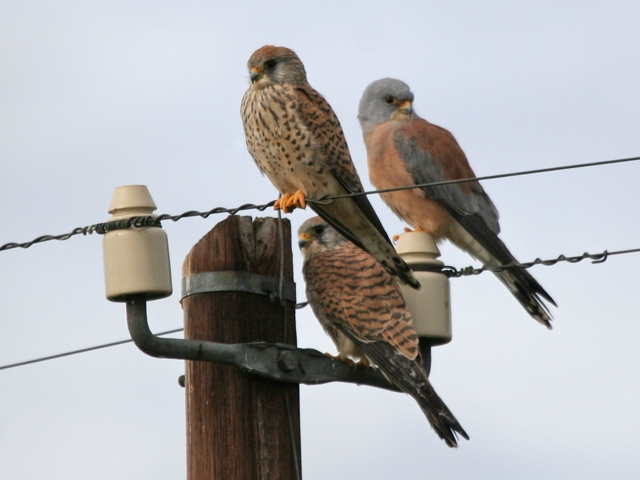
Figure 5:
Lesser Kestrels. One male on the right, two females to the left.
Source.
Aggression towards predators
The parakeet's aggression is nothing to shake a stick at.
There are incidental reports of them killing birds of prey, in addition to their aggressive displays(14).
Rose-ringed parakeets killed a red squirrel in France and a Leisler's bat in Italy.
Most evidence, however, is anecdotal and oversight is lacking.
Twenty-one occasions where rose-ringed parakeets attacked black rats (Rattus rattus) were studied.
Rats predate on the eggs and chicks of the parakeet and might even attack sleeping adults.
When a parakeet spots a rat climbing the trees, they let out a loud alarm call and aggressively chase the rat (figure 6).
They use physical aggression, sometimes biting the rat and leaving it wounded.
Importantly, in four cases, other birds nesting close by aided in chasing the rats.
The attacks stopped when the rat fell down the tree or reached the ground by itself.
In two of the twenty-one attacks, the rats perished(17). Unfortunately, these are isolated sightings.
It could well be that via these anti-predator effects, there is a positive effect on the native birds,
but more research is needed before we can be sure.

Figure 6:
A rose-ringed parakeet attacking a black rat.
Source.
Foraging behaviour
The last way in which rose-ringed parakeets could impact native species is with their foraging behaviour.
A pattern is emerging: we don't know whether they do.
Rose-ringed parakeets have a highly varied diet and eat non-native plants and human-provided food without problems(18).
In fact, it has been found that the parakeets spend half of their time feeding at artificial bird feeders.
These might be very important in the perseverance of the species(13).
Their varied diet and propensity to feed at bird feeders makes them very successful in exploiting food sources.
This has three effects. It decreases the amount of food native species can gather, forces them to consume lower value resources, and makes them spend more time on the lookout for the parakeets.
An important factor is the so-called neophobic avoidance response: a native species may at first be scared by the unknown newcomer and stop its normal behaviour.
This might be enhanced by the fact that rose-ringed parakeets feed in groups.
This response, however, is subject to habituation; after a while native species might get used to the parakeets.
As it is, though,
it was noted that native species spent far more time in vigilant behaviour when the parakeet was present,
instead of feeding.
The long-term effects of the parakeets' foraging behaviour are still unknown. There is no proof of the parakeets actually changing the population level of native species(18).
This parakeet established populations in many countries around the world,
but its effects on native species are poorly known. It seems not to outcompete others for nesting space, but the bats and lesser kestrels might come under pressure with further population growth. Its aggressive behaviour towards predators may help other birds, but strong evidence is lacking. In partaking of the available food, it might negatively affect other birds, but effects on native bird population size have not been found. This colourful new inhabitant of cities around the world is thus relatively harmless.
Let us see whether the same holds true for species that have entered the city of their own accord.
Outsiders encroach
What about enterprising species that enter the city by themselves?
The ever-expanding urban ecosystem forces species to adapt.
An example is the raccoon, a notorious feeder on trash.
Raccoons are smart enough to take advantage of sewers and storm drains.
At night, they quietly break into houses through pet doors,
using their nimble fingers to open any doors that might be in their way(7; 19).
In the next part of our story, we zoom in on two urban invaders:
boars and foxes that penetrate ever deeper into the cities.
All a-boar-d!
Boaring boulevards
Tusks, squeals and grunts, and mucking about in the soil.
The hallmarks of a good boar (Sus scrofa).
Boars have a high rate of reproduction, which sets them apart from other hooved animals.
In fact, they can triple their population in a year. They also have a high rate of dispersal.
Boars are hardy, and can adapt to many weather conditions. Females can mate at any time during the year(20).
Boar populations in Europe have been steadily rising in the past years, while boar hunting has declined(22).
Climate change, increased availability of food due to agriculture,
and absence of predators have all played a part in this(23).
While one might expect to find boars at petting zoos around the city,
one would not expect them to live in the city itself. Well, we have some news for you.
Boars can be found in the 30 km2 Grunewald forest in the southwest of Berlin,
where their search for acorns occupies them(19). In Barcelona, local boars roam in the Collserola Natural Park.
They are positively attracted to urban areas, uprooting gardens and tossing over rubbish bins for anthropogenic food(23).
Let us zoom in on the Berlin boars.
Berlin behaviours
There are between three and seven thousand boars in Berlin, and they can cause quite a stir.
They uproot gardens and soccer fields in their search for food, and can be dangerous when hurt.
Boars seem more and more present in the city.
This is a combined effect of actual population growth and bolder boar behaviours.
The boars have acclimated to people, daring to show themselves during the day and foraging in the city parks and gardens.
The boars ignore talking civilians that pass by.
When humans try to approach them stealthily, however, as a hunter would, they become restless and run away.
They have learned that the city is a safe haven.
While they can be freely hunted in the forest, that is illegal in the city.
During hunting season, it has been observed that boars move into the suburbs during the weekends,
when the hunters come, and return to the forests during the week, when the hunters are at work.
Female boars with young sometimes venture into the suburbia,
as there are no areas where people can take the leash off their dogs,
and other enemies are absent (Figure 7). Why Berlin? Because Berlin is the greenest city in Europe.
More than 42% of the city is green in some way, and 18% of its surface area is forest.
Green corridors link many of the green spaces, ideal passages for the boars.
In addition, agricultural practices on the border of Berlin help sustain the animals.
The rise in corn cultivation is especially appreciated by the boars, who love to eat this crop(19; 22; 24).
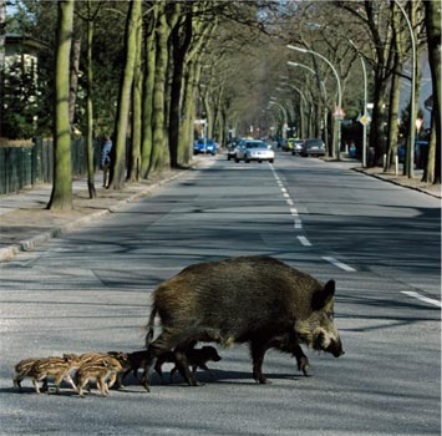
Figure 7:
A mother boar with her piglets on one of Berlin's city streets.
Source.
The pig pill
The amount of Berlin-dwelling boars more than doubled in a span of about 15 years, and this growth may well continue(24).
That causes problems.
As mentioned before, the boars ravage allotments and soccer fields, but they also cause many traffic accidents(19; 24).
Shooting the boars can be dangerous, difficult, and may not be the most effective way of containing the boar population.
Therefore, research has gone into immunocontraceptives that can be administered to the boars and make them infertile(25).
Administering these manually to all Berlin's boars is not cost-effective.
Fortunately, the immunocontraceptives could also be administered orally.
Feeding systems specific to boars are available,
so it is probably only a matter of time until these methods will be tried out to curb
explosive boar population growth with minimal discomfort for the animals(26).
Boars, then, are no longer solely forest dwellers.
Their habits, along with the large green spaces in modern cities,
have allowed them to move in and upturn numerous gardens in their search for food.
Luckily, their growth can be curbed in nonlethal ways.
Now, let us look at another urban invader with a beautiful red fur.
Foxy visitors
A prime example of a mammal that has prospered in the suburbia is the red fox (Vulpes vulpes).
It is an adaptable carnivore, that has acclimatised to habitats as diverse as the tundra, deserts, and the city.
It inhabits at least 114 cities worldwide, in the UK, mainland Europe, the US and Australia(27).
Its move into the cities in England is one of the most well-documented. It all starts around 1900.
By this time, the cities were still only that:
vast expanses of houses for the workers that formed the backbone of the Industrial Revolution.
Up to 125 houses were present per hectare.
A city was an intensely crowded place, where any greenery was a miracle.
Major changes were coming, however. Due to increased mobility, people could live further from their place of work.
To give you an idea of the magnitude of this effect, between 1918 and 1939, London's population grew by a quarter.
The size of the city tripled. But that was not all.
After 1930, there was an explosive increase in private house construction.
Cheap land meant that low housing densities were feasible.
This, in turn, meant that large expanses of suburban housing were created.
Housing with gardens and greenery(Figure 8) (28).

Figure 8:
1930's housing in a suburb of London.
Source.
It is these areas that foxes generally like.
Areas with industry, shops or council-rented houses have been shown to have a lower fox population than these suburbs.
This pattern was constant throughout cities in Britain(29).
Because the city slowly encroached on the rural land,
foxes were forced to live in closer contact with humans, and these suburbia became their homes.
Later on, the foxes probably migrated to less favourable areas further into the city(28).
The foxes, however, still need areas to dig their breeding dens, even in the city.
Concentrated housing with small gardens thus negatively impacts breeding(27).
All in all, the city encroached on fox territory, and now they walk the streets (Figure 9).

Figure 9:
an urban fox.
Source.
Dinner deluxe
What do foxes eat in their newfound habitats?
Foxes are very adaptable in the food they eat, and can subsist on many foods(27).
Specifically in London, foxes eat a large diversity of foodstuffs.
From scavenge to larvae of certain moths to rats and (pet) birds.
Birds were most important in the diet.
At the city edge, fox cubs ate less scavenged food and pet birds than at the city centre.
At the city centre, earthworms and insects in general were much less present in their stomach,
but more anthropogenic food was present(30).
Recent studies indicated that more than half of foxes' stomach contents are anthropogenic in origin.
The contents mostly consist of scavenged meat, other scavenge (bread, pasta, vegetable kitchen waste),
and crops and cultivated fruits. Bird, rodent, earthworm and insect remains were also identified in the stomachs.
Contrary to popular belief, foxes rarely rummage through bin liners in the city.
Foxes can make do with other, more secluded sources of food.
This is consistent with a study on foxes' feeding on tourist provisions.
Feeding behaviour was not correlated with the amount of tourist food available,
but rather with the availability of natural food.
Only if little natural food was available did foxes steal tourist provisions.
So it is in the cities: foxes are adept scavengers,
rummaging through compost heaps and finding all sorts of food waste, or gorging themselves on some dog food (Figure 10).
The amount of food facilitates continuous increase of the fox population(31). Does this cause any problems?
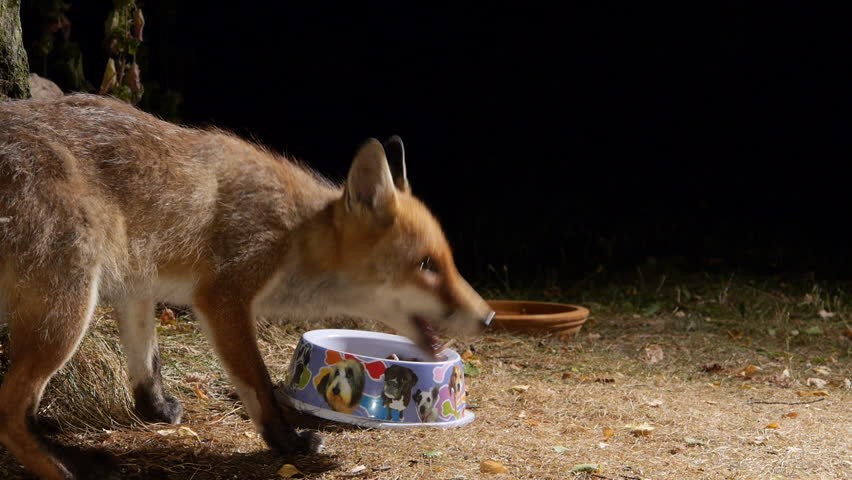
Figure 10:
a fox caught in action near a dog's food tray, moments before eating from it.
Source.
Peri-urban problems
In nature, foxes predate on many animals, including small rodents.
These rodents are the carriers of a parasite, Echinococcus multiocularis.
When foxes eat them, they in turn become infected.
Handling them or their droppings can transfer the parasite to humans, where it can cause alveolar echinococcosis.
This is a cyst-like larval growth, mostly in the liver. Surgery and medication are its treatments.
Dogs can also carry the parasite. In the city proper, foxes eat mainly anthropogenic food.
But in the peri-urban suburbs, where rural area crosses into urbanised areas, a problem may arise.
Here, fox numbers are higher, because they supplement hunting with human-provided food.
But they also hunt rodents, and are thus at higher risk of carrying the parasite.
In Nancy, France, only 4% of urban foxes checked had the parasite, but in Zurich, 44% carried it.
The fox concentration is higher in the suburbs, but there are also many dogs and people.
It might thus be that these are epicentres for Echinococcus transmission.
Various anti-worm fox baits were tested to lower parasite prevalence, with varying degrees of success.
More information is needed before definite danger of this parasite transmission can be accurately estimated(32).
Urban foxes cause surprisingly few other problems.
They do not often kill cats, though they might break into insecure henhouses or rabbit cages.
Attacks on humans are also very rare (27; 33; 34).
Foxes then, have successfully moved into the encroaching urban territories.
They eat a variety of foods and do not bother us much.
They might spread a parasite, but more research is needed to accurately determine the magnitude of that effect.
For now, many are enticed by the occasional sight of this sleek red hunter.
Conclusion
Parakeets, boars and foxes have all made the city their home.
They were introduced into an environment which they did not naturally inhabit.
The parakeets by man, the foxes and boars simply through the city encroaching ever so slightly on their territories.
Cities can lack natural predators of the newcomers, as is the case with boars and foxes.
Significantly, the city is extremely rich in food,
allowing for explosive population growth for any animal cunning or resourceful enough to make its home there.
A broad or omnivorous diet, concomitant with habituation to humans, helps, as foxes and boars show.
Adaptability is key. We may have crafted the cities as dwellings for ourselves,
but many cunning organisms can profit from the luxuries they provide.

















